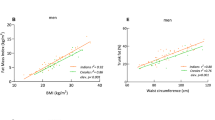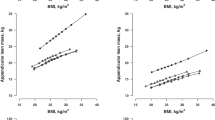Abstract
Background:
Small studies have shown that South Asians (SAs) have more total body, subcutaneous, visceral and hepatic fat and abnormal adipokine levels compared with Whites. However, comprehensive studies of body composition and adipokines in SAs compared with other ethnic groups are lacking.
Methods:
Using harmonized data, we performed a cross-sectional analysis of two community-based cohorts: Mediators of Atherosclerosis of South Asians Living in America (MASALA, n=906) and Multi-Ethnic Study of Atherosclerosis (MESA which included 2622 Whites, 803 Chinese Americans, 1893 African Americans and 1496 Latinos). General linear models were developed to assess the ethnic differences in ectopic fat (visceral, intermuscular and pericardial fat; and hepatic attenuation), lean muscle mass and adipokines (adiponectin and resistin). Models were adjusted for age, sex, site, alcohol use, smoking, exercise, education, household income and body mass index. Ectopic fat models were additionally adjusted for hypertension, diabetes, high-density lipoprotein and triglycerides. Adipokine models were adjusted for subcutaneous, visceral, intermuscular and pericardial fat; and hepatic attenuation.
Results:
Compared with all ethnic groups in MESA (Whites, Chinese Americans, African Americans and Latinos), SAs had greater intermuscular fat (pairwise comparisons with each MESA group, P<0.01), lower hepatic attenuation (P<0.001) and less lean mass (P<0.001). SAs had greater visceral fat compared with Chinese Americans, African Americans and Latinos (P<0.05) and greater pericardial fat compared with African Americans (P<0.001). SAs had lower adiponectin levels compared with other ethnic groups (P<0.01; except Chinese Americans) and higher resistin levels than all groups (P<0.001), even after adjusting for differences in body composition.
Conclusion:
There are significant ethnic differences in ectopic fat, lean mass and adipokines. A less favorable body composition and adipokine profile in SAs may partially explain the increased predisposition to cardiometabolic disease. The mechanisms that underlie these differences warrant further investigation.
This is a preview of subscription content, access via your institution
Access options
Subscribe to this journal
Receive 12 print issues and online access
$259.00 per year
only $21.58 per issue
Buy this article
- Purchase on Springer Link
- Instant access to full article PDF
Prices may be subject to local taxes which are calculated during checkout


Similar content being viewed by others
References
A Demographic Snapshot of South Asians in the United States: July 2012 Update, 2012. http://saalt.org/wp-content/uploads/2012/09/Demographic-Snapshot-Asian-American-Foundation-2012.pdf.
Kanaya AM, Herrington D, Vittinghoff E, Ewing SK, Liu K, Blaha MJ et al. Understanding the high prevalence of diabetes in U.S. south Asians compared with four racial/ethnic groups: the MASALA and MESA studies. Diabetes Care 2014; 37: 1621–1628.
Tillin T, Hughes AD, Mayet J, Whincup P, Sattar N, Forouhi NG et al. The relationship between metabolic risk factors and incident cardiovascular disease in Europeans, South Asians, and African Caribbeans: SABRE (Southall and Brent Revisited) — a prospective population-based study. J Am Coll Cardiol 2013; 61: 1777–1786.
Hajra A, Li Y, Siu S, Udaltsova N, Armstrong MA, Friedman GD et al. Risk of coronary disease in the South Asian American population. J Am Coll Cardiol 2013; 62: 644–645.
Bhopal RS . A four-stage model explaining the higher risk of type 2 diabetes mellitus in South Asians compared with European populations. Diabet Med 2013; 30: 35–42.
Deurenberg-Yap M, Schmidt G, van Staveren WA, Deurenberg P . The paradox of low body mass index and high body fat percentage among Chinese, Malays and Indians in Singapore. Int J Obes Relat Metab Disord 2000; 24: 1011–1017.
Razak F, Anand SS, Shannon H, Vuksan V, Davis B, Jacobs R et al. Defining obesity cut points in a multiethnic population. Circulation 2007; 115: 2111–2118.
Lear SA, Humphries KH, Kohli S, Chockalingam A, Frohlich JJ, Birmingham CL . Visceral adipose tissue accumulation differs according to ethnic background: results of the Multicultural Community Health Assessment Trial (M-CHAT). Am J Clin Nutr 2007; 86: 353–359.
Anand SS, Tarnopolsky MA, Rashid S, Schulze KM, Desai D, Mente A et al. Adipocyte hypertrophy, fatty liver and metabolic risk factors in South Asians: the Molecular Study of Health and Risk in Ethnic Groups (mol-SHARE). PLoS One 2011; 6: e22112.
Wasim H, Al-Daghri NM, Chetty R, McTernan PG, Barnett AH, Kumar S . Relationship of serum adiponectin and resistin to glucose intolerance and fat topography in South-Asians. Cardiovasc Diabetol 2006; 5: 10.
Shah A, Kanaya AM . Diabetes and associated complications in the South Asian population. Curr Cardiol Rep 2014; 16: 476.
Sniderman AD, Bhopal R, Prabhakaran D, Sarrafzadegan N, Tchernof A . Why might South Asians be so susceptible to central obesity and its atherogenic consequences? The adipose tissue overflow hypothesis. Int J Epidemiol 2007; 36: 220–225.
Bild DE, Bluemke DA, Burke GL, Detrano R, Diez Roux AV, Folsom AR et al. Multi-ethnic study of atherosclerosis: objectives and design. Am J Epidemiol 2002; 156: 871–881.
Kanaya AM, Kandula N, Herrington D, Budoff MJ, Hulley S, Vittinghoff E et al. Mediators of Atherosclerosis in South Asians Living in America (MASALA) Study: Objectives, Methods, and Cohort Description. Clin Cardiol 2013; 36: 713–720 5.
Ainsworth BE, Irwin ML, Addy CL, Whitt MC, Stolarczyk LM . Moderate physical activity patterns of minority women: the Cross-Cultural Activity Participation Study. J Womens Health Gend Based Med 1999; 8: 805–813.
American Diabetes Association. Standards of medical care for patients with diabetes mellitus. Diabetes Care 2003; 26: S33–S50.
McAuliffe M . Medical Image Processing, Analysis, and Visualization (MIPAV). National Institutes of Health: Bethesda, MD, USA, 2009.
Senseney J, Hemler P, McAuliffe M . Automated segmentation of computed tomography images. CBMS, 22nd IEEE International Symposium 2009; 1–7. doi: 10.1109/CBMS.2009.5255342.
Barrett WA, Mortensen EN . Interactive live-wire boundary extraction. Med Image Anal 1997; 1: 331–341.
Cohen L, Cohen I . Finite-element methods for active contour models and balloons for 2-D and 3-D images. Pattern Analysis and Machine Intelligence, IEEE Transactions 1993; 15: 1131–1147.
Kass M, Witkin A, Terzopoulos D . Snakes: Active contour models. Intl Jo Computer Vision 1988; 1: 321–331.
Tota-Maharaj R, Blaha MJ, Zeb I, Katz R, Blankstein R, Blumenthal RS et al. Ethnic and sex differences in fatty liver on cardiac computed tomography: the multi-ethnic study of atherosclerosis. Mayo Clin Proc 2014; 89: 493–503.
Misra A, Khurana L . Obesity-related non-communicable diseases: South Asians vs White Caucasians. Int J Obes (Lond) 2011; 35: 167–187.
Shah A, Hernandez A, Mathur D, Budoff MJ, Kanaya AM . Adipokines and body fat composition in South Asians: results of the Metabolic Syndrome and Atherosclerosis in South Asians Living in America (MASALA) study. Int J Obes (Lond) 2012; 36: 810–816.
Sandeep S, Gokulakrishnan K, Velmurugan K, Deepa M, Mohan V . Visceral & subcutaneous abdominal fat in relation to insulin resistance & metabolic syndrome in non-diabetic south Indians. Indian J Med Res 2010; 131: 629–635.
Indulekha K, Anjana RM, Surendar J, Mohan V . Association of visceral and subcutaneous fat with glucose intolerance, insulin resistance, adipocytokines and inflammatory markers in Asian Indians (CURES-113). Clin Biochem 2011; 44: 281–287.
Rush EC, Freitas I, Plank LD . Body size, body composition and fat distribution: comparative analysis of European, Maori, Pacific Island and Asian Indian adults. Br J Nutr 2009; 102: 632–641.
Lear SA, Chockalingam A, Kohli S, Richardson CG, Humphries KH . Elevation in cardiovascular disease risk in South Asians is mediated by differences in visceral adipose tissue. Obesity (Silver Spring) 2012; 20: 1293–1300.
Banerji MA, Faridi N, Atluri R, Chaiken RL, Lebovitz HE . Body composition, visceral fat, leptin, and insulin resistance in Asian Indian men. J Clin Endocrinol Metab 1999; 84: 137–144.
Raji A, Seely EW, Arky RA, Simonson DC . Body fat distribution and insulin resistance in healthy Asian Indians and Caucasians. J Clin Endocrinol Metab 2001; 86: 5366–5371.
Addison O, Marcus RL, Lastayo PC, Ryan AS . Intermuscular fat: a review of the consequences and causes. Int J Endocrinol 2014; 2014: 309570.
Eastwood SV, Tillin T, Wright A, Mayet J, Godsland I, Forouhi NG et al. Thigh fat and muscle each contribute to excess cardiometabolic risk in South Asians, independent of visceral adipose tissue. Obesity (Silver Spring) 2014; 22: 2071–2079.
Bajaj S, Nigam P, Luthra A, Pandey RM, Kondal D, Bhatt SP et al. A case-control study on insulin resistance, metabolic co-variates & prediction score in non-alcoholic fatty liver disease. Indian J Med Res 2009; 129: 285–292.
Pan JJ, Fallon MB . Gender and racial differences in nonalcoholic fatty liver disease. World J Hepatol 2014; 6: 274–283.
Iacobellis G, Leonetti F . Epicardial adipose tissue and insulin resistance in obese subjects. J Clin Endocrinol Metab 2005; 90: 6300–6302.
McAuley PA, Hsu FC, Loman KK, Carr JJ, Budoff MJ, Szklo M et al. Liver attenuation, pericardial adipose tissue, obesity, and insulin resistance: the Multi-Ethnic Study of Atherosclerosis (MESA). Obesity (Silver Spring) 2011; 19: 1855–1860.
Miller WJ, Sherman WM, Ivy JL . Effect of strength training on glucose tolerance and post-glucose insulin response. Med Sci Sports Exerc 1984; 16: 539–543.
Lear SA, Kohli S, Bondy GP, Tchernof A, Sniderman AD . Ethnic variation in fat and lean body mass and the association with insulin resistance. J Clin Endocrinol Metab 2009; 94: 4696–4702.
Chandalia M, Lin P, Seenivasan T, Livingston EH, Snell PG, Grundy SM et al. Insulin resistance and body fat distribution in South Asian men compared to Caucasian men. PLoS One 2007; 2: e812.
Steppan CM, Bailey ST, Bhat S, Brown EJ, Banerjee RR, Wright CM et al. The hormone resistin links obesity to diabetes. Nature 2001; 409: 307–312.
Valsamakis G, Chetty R, McTernan PG, Al-Daghri NM, Barnett AH, Kumar S . Fasting serum adiponectin concentration is reduced in Indo-Asian subjects and is related to HDL cholesterol. Diabetes Obes Metab 2003; 5: 131–135.
Mente A, Razak F, Blankenberg S, Vuksan V, Davis AD, Miller R et al. Ethnic variation in adiponectin and leptin levels and their association with adiposity and insulin resistance. Diabetes Care 2010; 33: 1629–1634.
Sulistyoningrum DC, Gasevic D, Lear SA, Ho J, Mente A, Devlin AM . Total and high molecular weight adiponectin and ethnic-specific differences in adiposity and insulin resistance: a cross-sectional study. Cardiovasc Diabetol 2013; 12: 2840–12-170.
Acknowledgements
We thank the other investigators, the staff and the participants of the MASALA and MESA studies for their valuable contributions. A full list of participating MESA investigators and institutions can be found at http://www.mesa-nhlbi.org. The MASALA study was supported by the NIH grant no.1R01 HL093009 and K24HL112827. Data collection at UCSF was supported by NIH/NCRR UCSF-CTSI Grant Number UL1 RR024131. Dr Shah was supported by NIH grant 5T32DK007418-34, the Wilsey Family Foundation and the Cliff Lede Family Foundation. The MESA study was funded by contracts N01-HC-95159, N01-HC-95160, N01-HC-95161, N01-HC-95162, N01-HC-95163, N01-HC-95164, N01-HC-95165, N01-HC-95166, N01-HC-95167, N01-HC-95168 and N01-HC-95169 from the National Heart, Lung, and Blood Institute and by grants UL1-TR-000040 and UL1-TR-001079 from NCRR. The pericardial fat and hepatic attenuation measurements for MESA were supported by NIH grant 5RO1HL085323-04. The MESA Body Composition, Inflammation and Cardiovascular Disease Ancillary Study was supported by NIH grant RO1-HL088451. The sponsors for both studies did not have a significant role in the analysis, interpretation and presentation of these results.
Author information
Authors and Affiliations
Corresponding author
Ethics declarations
Competing interests
The authors declare no conflict of interest.
Additional information
Supplementary Information accompanies this paper on International Journal of Obesity website
Rights and permissions
About this article
Cite this article
Shah, A., Kandula, N., Lin, F. et al. Less favorable body composition and adipokines in South Asians compared with other US ethnic groups: results from the MASALA and MESA studies. Int J Obes 40, 639–645 (2016). https://doi.org/10.1038/ijo.2015.219
Received:
Revised:
Accepted:
Published:
Issue Date:
DOI: https://doi.org/10.1038/ijo.2015.219
This article is cited by
-
Adipose tissue-derived metabolite risk scores and risk for type 2 diabetes in South Asians
International Journal of Obesity (2024)
-
Effect of empagliflozin on cardiac remodelling in South Asian and non-South Asian individuals: insights from the EMPA-HEART CardioLink-6 randomised clinical trial
BMC Cardiovascular Disorders (2023)
-
Body composition and risk factors for cardiovascular disease in global multi-ethnic populations
International Journal of Obesity (2023)
-
A Strategic Research Framework for Defeating Diabetes in India: A 21st-Century Agenda
Journal of the Indian Institute of Science (2023)
-
Obesity and Cardiovascular Risk Among South Asian Americans
Current Cardiovascular Risk Reports (2023)



